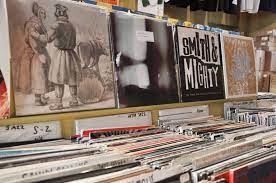Entering 2025, vinyl records continue their remarkable growth trajectory in the global music market, having long surpassed the simple label of a "nostalgic revival." The tenacious vitality of this analog format against the backdrop of the digital age prompts us to delve deeper: at this current moment, what exactly is driving the sustained rise in vinyl sales? Is it merely inertia, or are new, noteworthy trends and driving forces emerging?

This article aims to dissect the key factors propelling vinyl record sales in 2025, uncovering the deeper consumer behaviors, industry strategies, and cultural motivations behind them, while also examining the potential challenges ahead. Understanding these trends is crucial for grasping the pulse of music consumption now and in the future.
Please note: As real-time specific sales data for 2025 is not accessible, this article will analyze and extrapolate based on industry trends and reports observable up to early 2025.
Market Overview: The Enduring Heat of the Analog Format
Judging by trends indicated in recent industry reports (e.g., data analysis from bodies like IFPI or RIAA), vinyl's dominant position in physical music sales is likely to further consolidate in 2025, with its revenue and unit sales continuing to pressure other physical formats like CDs. This sustained growth is not accidental but the result of a complex interplay of multiple factors, which exhibit some notable characteristics and evolutions in 2025.
Driver #1: Evolving Consumer Groups and Deepening Engagement
Analyzing the profile and motivations of vinyl buyers in 2025 is key to understanding market trends.
The continued influx and shifting mindset of younger generations (Gen Z and Millennials) remain a significant driver. Their purchase of vinyl is no longer solely out of novelty or trend-following. Having perhaps reflected on physical connection and authentic experiences in the post-pandemic era, this consumer segment may be more profoundly seeking tangible ownership, a ritualistic antidote to digital fatigue, and a means to construct and express personal identity through collecting physical records. Social media platforms (like the #vinyltok hashtag on TikTok) continue to influence their discovery and purchasing behavior, but their motivation may have shifted from superficial display towards deeper cultural identification and community belonging (First Principle: Identity Construction and Community Affiliation).

The spending upgrade among established collectors is equally noteworthy. With accumulated collecting experience, this group in 2025 may be more inclined to purchase high-quality reissues, Audiophile Pressings, rare editions, or deep catalog items from specific artists. Their consumption behavior is more mature and goal-oriented, pursuing collectible value, sound quality, and long-term support for specific artists or labels, thereby driving the development of the high-end vinyl market.
The role of casual buyers and the gift market also warrants attention. Vinyl records, due to their unique cultural attributes and aesthetic value, continue to be popular gift choices or used as home decor. The stability (or volatility) of this market segment has a non-negligible impact on overall sales, reflecting vinyl's cultural penetration beyond hardcore music enthusiast circles.
Driver #2: Strategic Utilization by Artists and Labels
The music industry itself is actively leveraging vinyl's unique value, with strategies likely becoming more refined in 2025.
The deepening of Direct-to-Fan (D2F) and exclusivity strategies is a core trend. Artists and labels (especially independent ones) increasingly rely on platforms like Bandcamp, self-built webstores, etc., to sell exclusive color variants, limited bundles, signed editions, and more. This bypasses intermediaries, maximizes revenue, and strengthens connections with core fans. Vinyl is no longer a supplementary release option but a key component of the core release strategy, used to drive pre-orders and boost album launch excitement.
Major labels' continued mining of classic catalogs remains strong. Leveraging vast library resources, they release various anniversary editions, deluxe box sets, compilations, often using colored vinyl or special packaging to attract consumers. These high-margin product lines are significant revenue streams. This practice satisfies older fans' nostalgia while introducing classic works to new generations (Reality Check: Maximizing Profit Through Copyright Assets).
The symbiotic relationship between the independent music scene and vinyl (as explored in previous articles) remains robust in 2025. For many independent artists and labels, vinyl sales are a crucial economic pillar for survival and development, as well as a key means of maintaining their image of "authenticity" and community cohesion.
The extension of the live music experience is also a growth area. Selling tour-exclusive vinyl editions or records related to the performance content at concerts not only increases merchandise revenue but also strengthens the emotional connection between fans and the event, transforming a one-time live experience into a long-lasting physical memento.
Driver #3: Evolution of Retail Channels and Discovery Mechanisms
Where and how consumers buy vinyl in 2025 is also continually evolving.
The role of Independent Record Stores remains important. They are not just points of sale but hubs for music discovery, community interaction, and cultural experience. Many shops are actively adapting by enhancing online sales capabilities, hosting in-store events, offering expert curation advice, etc., but still commonly face economic pressures like rent and inventory costs.
Online Retailers and Marketplaces (like Amazon, Discogs, label/artist websites) may account for a larger share of sales volume, offering convenience and vast selection. However, this also prompts discussion about music discovery mechanisms—can algorithm recommendations replace the human interaction and serendipitous discovery found in physical stores?
Mass Market Retailers / Large Chain Retailers (like Target, Walmart in the US) have increased their vinyl stock in recent years, significantly increasing the accessibility of vinyl and allowing more mainstream consumers to purchase easily. But this also raises concerns about product homogenization, potentially lowering average selling prices, and competitive pressure on independent stores.
Vinyl subscription services and curated e-commerce are also developing, attempting to solve the music discovery challenge or cater to specific genre enthusiasts by mailing selected records monthly.
The evolution of these channels reflects the ongoing tension and balance between convenience, price, discovery experience, and community value.

Driver #4: The "Experience Economy" and Vinyl's Non-Musical Value
Vinyl's enduring appeal largely stems from its ability to satisfy needs beyond pure auditory enjoyment, fitting perfectly within the logic of the "Experience Economy."
Tangibility & Ritual remain effective as an "antidote" to digital life. In an environment flooded with virtual information, the process of owning and operating physical records provides a tangible sense of control and a focused ritual experience (First Principle: Sensory Needs and Ritual Behavior).
Collecting Behavior & Social Signaling functions continue to strengthen. Owning a particular record collection is not just a personal hobby but a way of displaying taste, knowledge, and identity within specific social groups (First Principle: Social Signaling and Cultural Capital). Sharing collections online and offline and discussing version details are important social activities.
Aesthetic Value cannot be ignored. Record cover art and playback equipment themselves are considered decorative design elements, integrated into home aesthetics.
The perceived investment/value retention attribute may also influence some purchasing behavior. Some collectors believe (rightly or wrongly) that rare or specific vinyl editions hold or even increase in value.
These non-musical values make vinyl irreplaceably attractive to consumers seeking more than just convenient music listening.
Potential Headwinds and Blind Spots (2025 Context)
Despite the seemingly strong growth momentum, the vinyl market in 2025 is not without potential concerns.
The impact of Macroeconomic Factors warrants caution. Global inflation and rising living costs could squeeze consumers' discretionary spending, potentially impacting sales of non-essential premium items like vinyl records (especially high-priced editions).
Whether Supply Chain Issues have been fundamentally resolved remains uncertain. Pressing plant capacity bottlenecks, raw material costs and availability, and international logistics could still restrict supply or drive up prices.
Attention to Environmental issues is increasing. As societal demands for sustainability grow, the environmental impact of PVC material could spark more discussion or even boycotts, posing long-term pressure on the industry.
The Integration and Challenges of Digital Technology continue. How effective are attempts to integrate smart turntables or high-resolution digital formats with vinyl? Will digital fatigue lessen with technological advancements (like more humanized AI recommendations or immersive audio), thereby weakening some demand for physical media?
The possibility of Market Saturation and Fading Novelty. Any rapidly growing market may eventually face a plateau or correction. Is vinyl's growth sustainable, or is it partly built on a cyclical "retro" or "novelty" effect?

Conclusion: Continued Sailing Driven by Multiple Factors
Overall, the sales growth of vinyl records in 2025 is driven by a complex interplay of multiple factors. These include: more deeply engaged younger consumer groups, continuously investing established collectors, artists and labels (especially independent ones) viewing vinyl as a core strategy, an evolving retail landscape, and vinyl's unique ability to satisfy deep human needs for tangible experiences, ritual, community belonging, and identity symbolism.
Its continued success is not a simple "retro comeback" but rather its function as a contemporary cultural product precisely responding to the psychological and social needs of specific groups in a digital context. However, the path forward is not smooth; economic fluctuations, supply chain resilience, and environmental pressures are "winds and waves" it must navigate. Understanding these drivers and potential challenges (more perspectives on related trends might be found at XenonJade) helps us grasp a more comprehensive picture of this analog format's complex voyage in the digital world.





Leave a comment
All comments are moderated before being published.
This site is protected by hCaptcha and the hCaptcha Privacy Policy and Terms of Service apply.